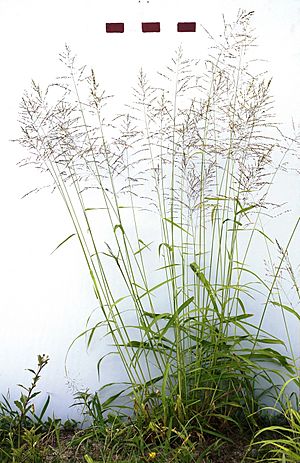Megathyrsus maximus facts for kids
Quick facts for kids Megathyrsus maximus |
|
|---|---|
 |
|
| Scientific classification | |
| Genus: |
Megathyrsus
|
| Species: |
maximus
|
| Synonyms | |
|
|
Megathyrsus maximus, often called Guinea grass or green panic grass, is a tall plant. It is a perennial bunch grass, meaning it grows in clumps and comes back year after year. This grass originally comes from Africa and Yemen.
Over time, people have taken Guinea grass to many warm, tropical places around the world. Before 2003, it was known by other scientific names, like Urochloa maxima and Panicum maximum.
Contents
What Guinea Grass Looks Like
Guinea grass naturally grows in open grasslands. You can often find it under or near trees and shrubs. It also likes to grow along riverbanks. This tough grass can survive wildfires and long periods without rain, known as drought.
The size and shape of Guinea grass can vary a lot. It can grow from about 0.5 m (1.6 ft) (1.6 feet) to 3.5 m (11 ft) (11.5 feet) tall. Its stems are usually 5–10 cm (2.0–3.9 in) (2-4 inches) thick.
How Guinea Grass Reproduces
One interesting thing about Guinea grass is how it makes new plants. It can reproduce through a process called apomixis. This means it can create seeds that are exact copies, or clones, of the parent plant. It doesn't need another plant to make seeds this way.
The plant produces open flower clusters called Panicles. Each plant can make a huge number of seeds, sometimes as many as 9,000!
Uses of Guinea Grass
Guinea grass is very useful, especially for feeding animals. Farmers often use it as a long-term food source for their livestock. Animals can graze on it directly if the grass is kept short and given enough fertilizer.
Another way it's used is called "cut-and-carry." In this method, farmers harvest the grass and bring it to animals like cows or goats that are kept in pens. This ensures the animals get fresh food.
Because Guinea grass can grow well in the shade, it's good for agroforestry. This is a system where trees and crops or grasses are grown together on the same land. Some types of Guinea grass are also used to make silage (fermented animal feed) and hay (dried grass). The leaves of Guinea grass are rich in protein, which is important for animal health. The amount of protein can be between 6% and 25%, depending on how old the grass is and how much nitrogen it gets.
Guinea Grass as an Invasive Species
While useful in some places, Guinea grass can be a problem in others. In areas like South Texas, Sri Lanka, and Hawai'i, it is considered an invasive weed. This means it spreads quickly and can take over areas where native plants used to grow. When it takes over, it can push out the local plants.
Guinea grass can also be a fire hazard. Because it grows tall and dense, it can dry out and become fuel for wildfires. This makes fires more likely and more dangerous.
In Australia, Guinea grass was brought to the state of Queensland between 1865 and 1869 by a group called the Queensland Acclimatisation Society. They introduced it to 22 different places.
See also
 In Spanish: Hierba de Guinea para niños
In Spanish: Hierba de Guinea para niños

